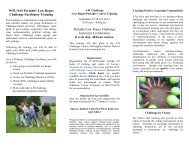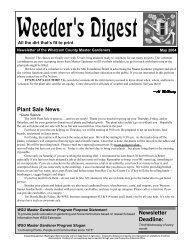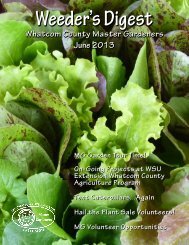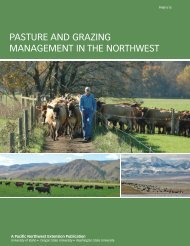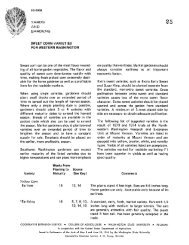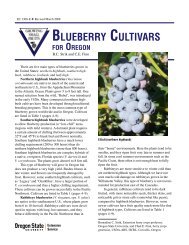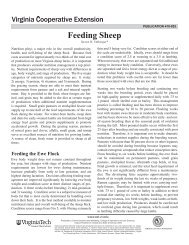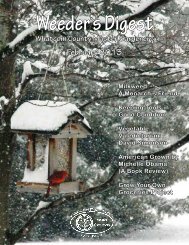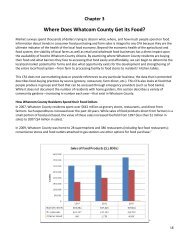August - WSU Whatcom County Extension - Washington State ...
August - WSU Whatcom County Extension - Washington State ...
August - WSU Whatcom County Extension - Washington State ...
You also want an ePaper? Increase the reach of your titles
YUMPU automatically turns print PDFs into web optimized ePapers that Google loves.
Weeder’s Digest<br />
Tis the Season<br />
By Faye Agner<br />
It seems as though summer is here.<br />
It got off to rather a stuttering start with<br />
unexpected rain in July. Now we can get<br />
on with our summer plans. If you are<br />
going to be gone, be sure and not leave<br />
signs of your being away by having<br />
newspapers, etc. pile up. Your neighbors<br />
will not thank you for this. Maybe you<br />
can bribe one of your friends/neighbors<br />
to take care of watering and such while<br />
you are gone. Tell them they can harvest<br />
from your garden as a reward.<br />
Now is the time to start planning<br />
for your winter and fall garden. Plant<br />
beets, cole crops (broccoli, cabbage,<br />
collards, kale, kohlrabi), leeks, lettuce,<br />
onions, peas, radishes, and spinach.<br />
<strong>August</strong> is the best time to prune<br />
fruit trees as it can help prevent rampant<br />
sprout growth next spring. Pruning at<br />
this time removes many of the leaves that<br />
transfer energy in fall to be used by the<br />
tree for growth in the spring. As long as<br />
you don’t remove more than a third of the<br />
foliage, the energy loss will not harm the<br />
tree. Prune to give the tree a vase shape<br />
rather than that of an umbrella. There is a<br />
hormone that makes growth happen at<br />
the highest point in the tree. If the center<br />
is the highest point, you get the Medusa<br />
effect with hundreds of sprouts growing<br />
right out of the middle. If the outer<br />
branches aim upward, the hormone<br />
causes growth where it is needed, at the<br />
tips of the branches, and sprout growth<br />
will be much less.<br />
As a general rule, fruit trees don’t<br />
need to be fertilized, instead, they need to<br />
be watered regularly in order to produce<br />
juicy, delicious fruit. As with most trees,<br />
the best way to water is with a soaker<br />
hose. The sun tends to degrade soaker<br />
hoses, so don’t forget to cover them with<br />
at least an inch of mulch. As an added<br />
benefit, the mulch will slow evaporation,<br />
cool the soil temperatures and make the<br />
water spread more evenly over the root<br />
zone.<br />
A trick to growing huge lilies next<br />
year is to feed them now, right after they<br />
quit blooming. Food manufactured in the<br />
leaves is sent down to be stored as<br />
energy in the bulb. The more energy<br />
stored, the bigger the bulb and the more<br />
spectacular your lily display will be next<br />
summer. Give your lilies a shot of organic<br />
bulb food now, and you will be rewarded<br />
with huge flowering stalks next summer.<br />
Powdery mildew is a common<br />
problem this time of year. Odd as it<br />
seems, the easiest way to prevent this<br />
fungus is to water adequately. Underwatered<br />
plants are highly susceptible.<br />
Powdery mildew is the only fungus that<br />
lives on the outside of the leaves. Unlike<br />
other fungus diseases, it can be easily<br />
controlled if a spray is applied at the first<br />
sign of the disease (it is too late once the<br />
leaves are covered).<br />
Bald-faced hornets are beneficial.<br />
These are the bees that make paper wasp<br />
nest in trees and shrubs like rhododendrons.<br />
They are large black (white spots<br />
on the head and rump) yellow jackets and<br />
eat lots of plant eating bugs. For fun,<br />
watch them hover just above the lawn<br />
looking for crane flies. The crane fly<br />
hides in the grass waiting for a chance to<br />
lay her eggs. If she is spotted by a baldfaced<br />
hornet as she is taking off, the<br />
hornet will swoop down and bite the<br />
crane fly’s head off in mid air. Next to be<br />
bitten off are the wings and the legs. The<br />
remainder of the crane fly is then taken<br />
back to the nest. Put up warning signs<br />
and barricades to make sure the kids and<br />
the dog don’t go near the nest.<br />
Tend your roses now. For a second<br />
flush of bloom in fall, give roses plenty of<br />
water during the warm <strong>August</strong> days and<br />
feed them with a complete fertilizer. Also,<br />
apply iron chelate if leaves look chloroic<br />
(yellow with green veins). Make certain<br />
the soil is moist before applying and<br />
water thoroughly afterward. Snip off old<br />
blooms and rose hips; lightly shape<br />
plants if necessary.<br />
Uneven watering causes cracked<br />
tomatoes. Cracked tomatoes are not only<br />
unappetizing; they are also quick to spoil.<br />
To avoid this problem, keep your<br />
tomatoes watered. If they are allowed to<br />
dry out and then are watered the plant<br />
takes up too much too quickly and the<br />
excess is stored in the fruit. The fruit<br />
cracks because as the skin turns red, it<br />
also looses flexibility and can’t expand to<br />
accommodate the excess fluid. To solve<br />
the problem, irrigate regularly and apply<br />
mulch to keep the soil evenly moist.<br />
Your plants will last better and take<br />
less watering by mulching around the<br />
roots to keep them cool. Mulch also<br />
helps water soak into the soil rather than<br />
run off and it slows evaporation. Mulching<br />
can take the form of organic material<br />
such as shredded leaves, which helps<br />
improve the soil as it conserves moisture.<br />
Let the size of your plant be your guide<br />
as to how deep to spread it. The larger<br />
the plant, the more mulch it can handle.<br />
You do not want to bury your low<br />
growing plants. If you do not have leaf<br />
mulch, shredded wood or bark works fine.<br />
It will not break down as fast to improve<br />
the soil. Be careful about using stone or<br />
gravel mulch. It can actually get very hot<br />
and cause moisture to evaporate rather<br />
than conserving it.<br />
If you don’t already have a<br />
compost pile, here is an easy way to start<br />
one. To hold the compost, join four 4-by<br />
4-foot square wood pallets, the kind used<br />
in home and garden stores, often<br />
available free if they are damaged, at the<br />
corners to make a bottomless, opentopped<br />
box. Toss in a blend of vegetable<br />
scraps (everything from apple cores to<br />
carrot tops) and garden waste such as<br />
grass clippings and seedless weeds.<br />
Water the pile to keep it as moist as a<br />
wrung-out sponge and turn it weekly<br />
with a garden fork. You’ll have rich<br />
compost in a couple of months. As you<br />
tear out spent summer flowers and<br />
vegetables, combine them with the grass<br />
clippings and non-meat kitchen waste to<br />
make compost for your fall garden.<br />
Who am I?<br />
I am from a genus of about 9<br />
species of bold, stiff perennials from dry<br />
prairies, gravelly hillsides, and open<br />
woodland in Central and Eastern North<br />
America. I usually have thick black<br />
rootstocks and short rhizomes. Erect,<br />
hairy stems bear linear-lance-shaped to<br />
ovate, entire, toothed or deeply pinnatifid,<br />
bristly, dark green leaves. Solitary,<br />
daisy-like, purple, red, pink or white<br />
flower-heads with pointed stiff scales on<br />
the undersides, and prominate, ovid or<br />
cone-shaped brownish yellow to orange<br />
central discs are produced on terminally,<br />
thick branched stems.



